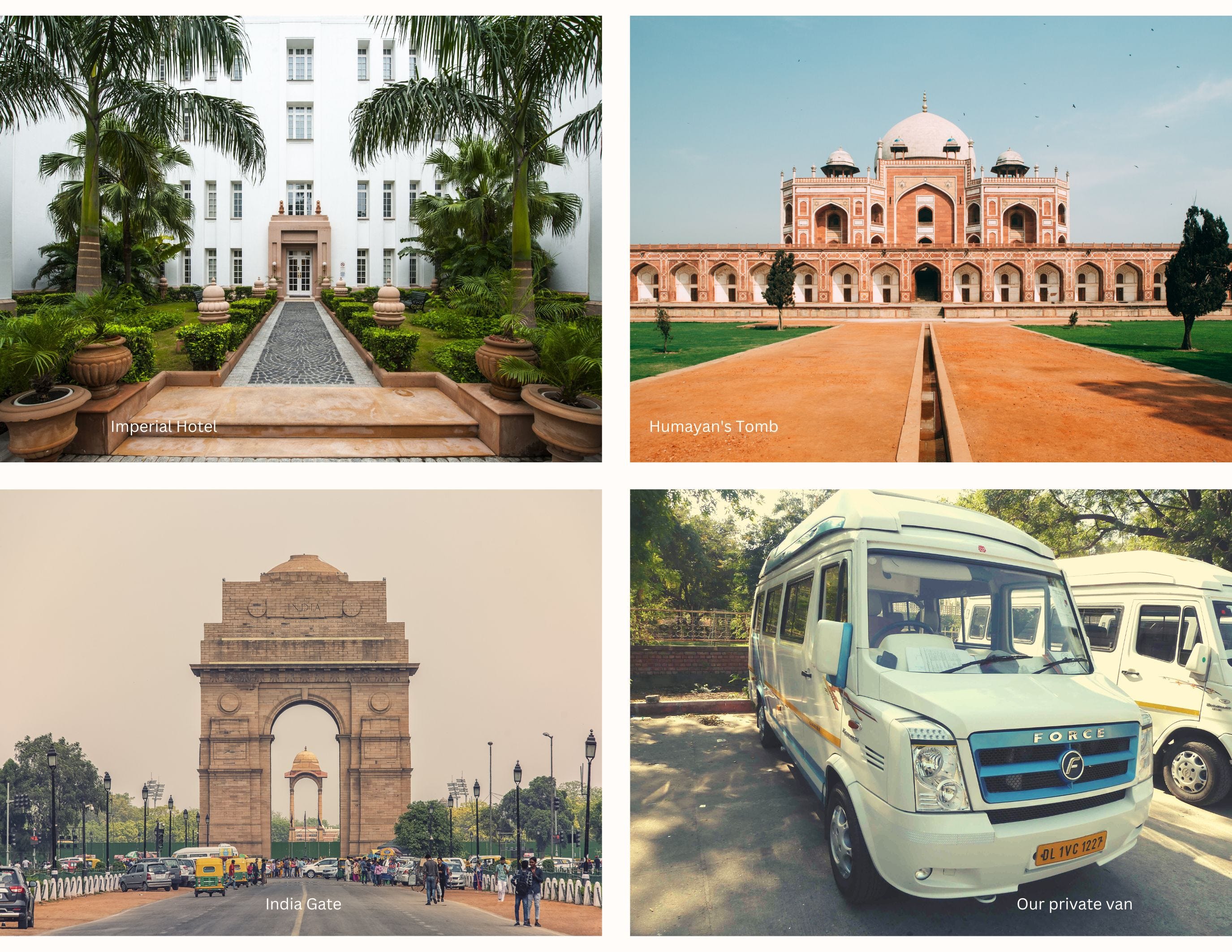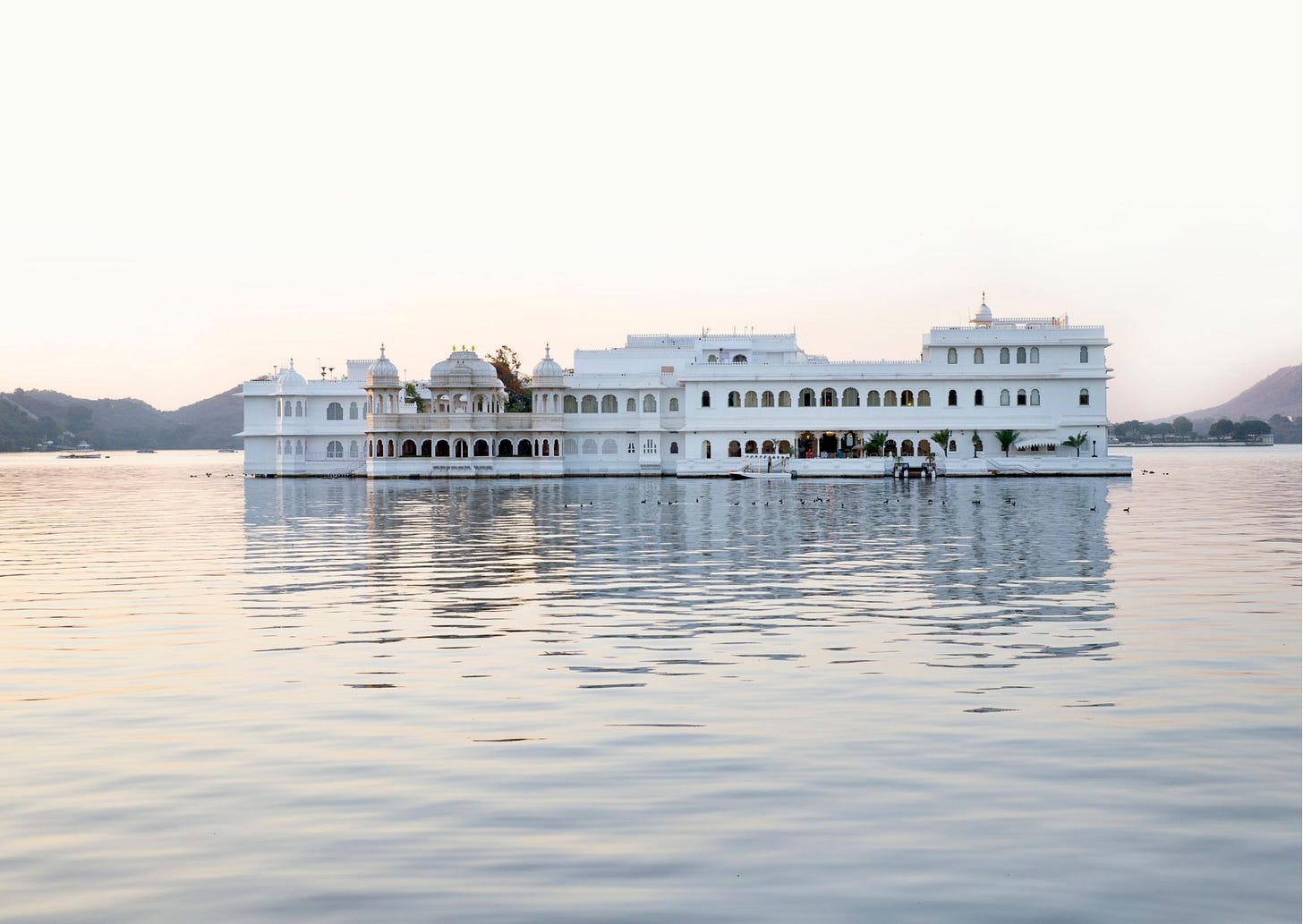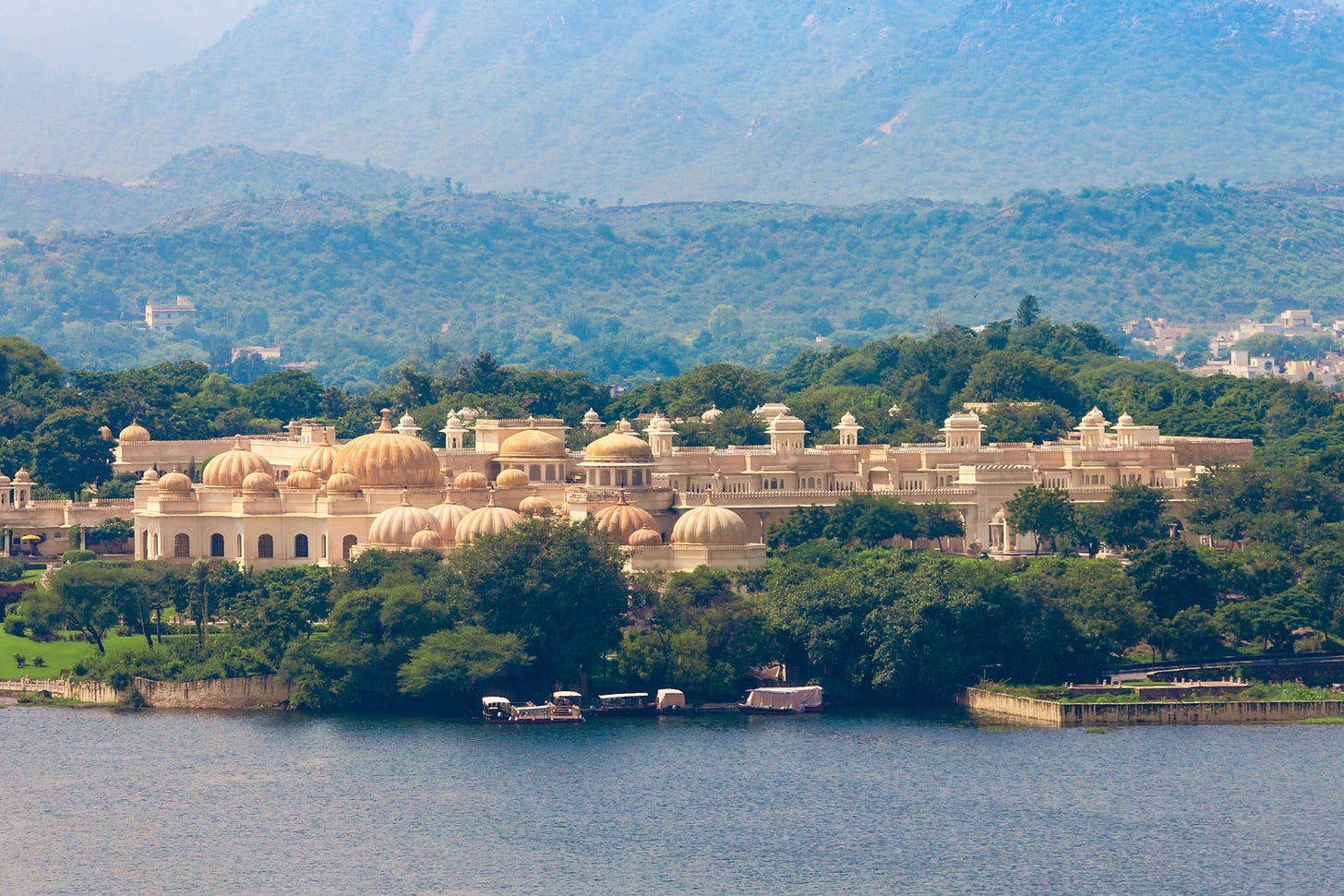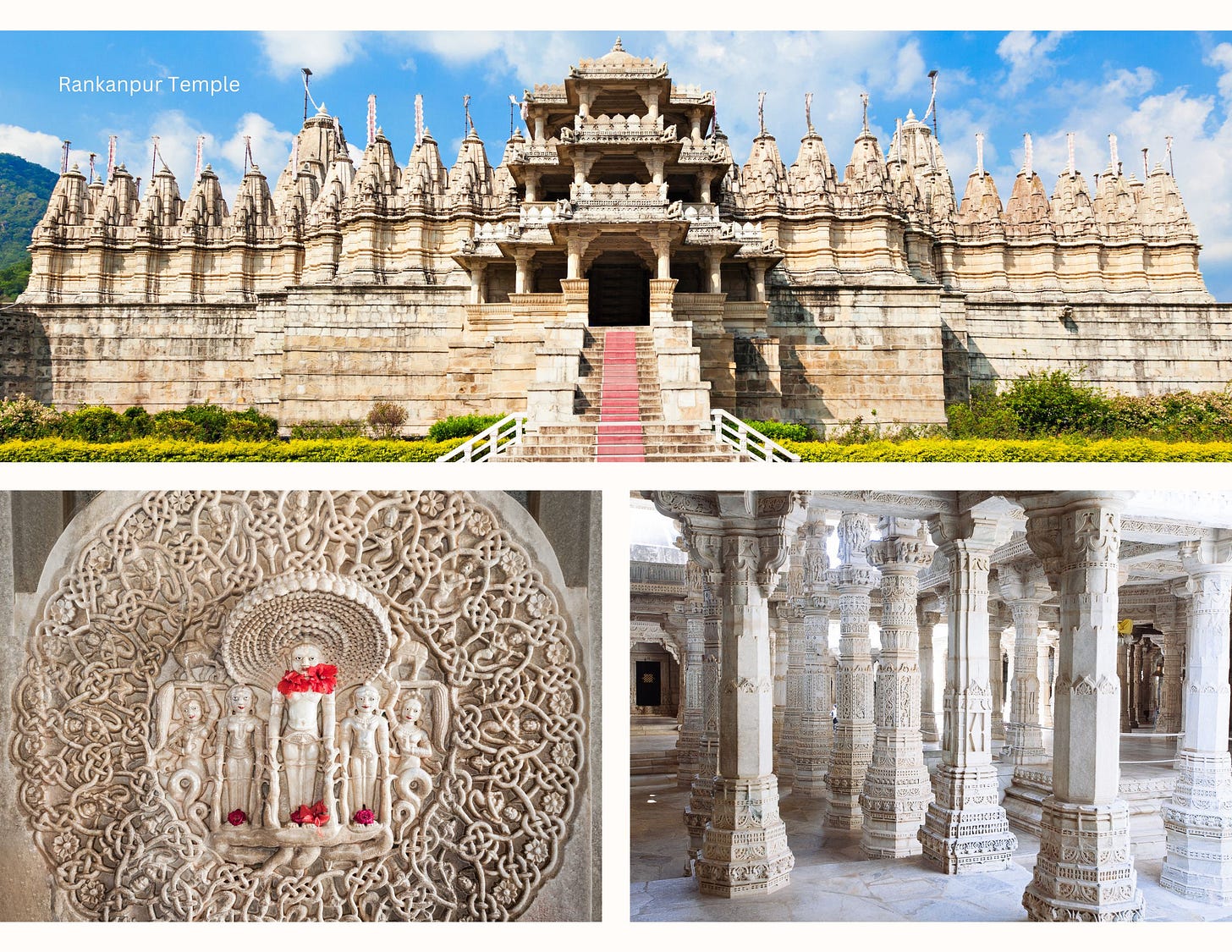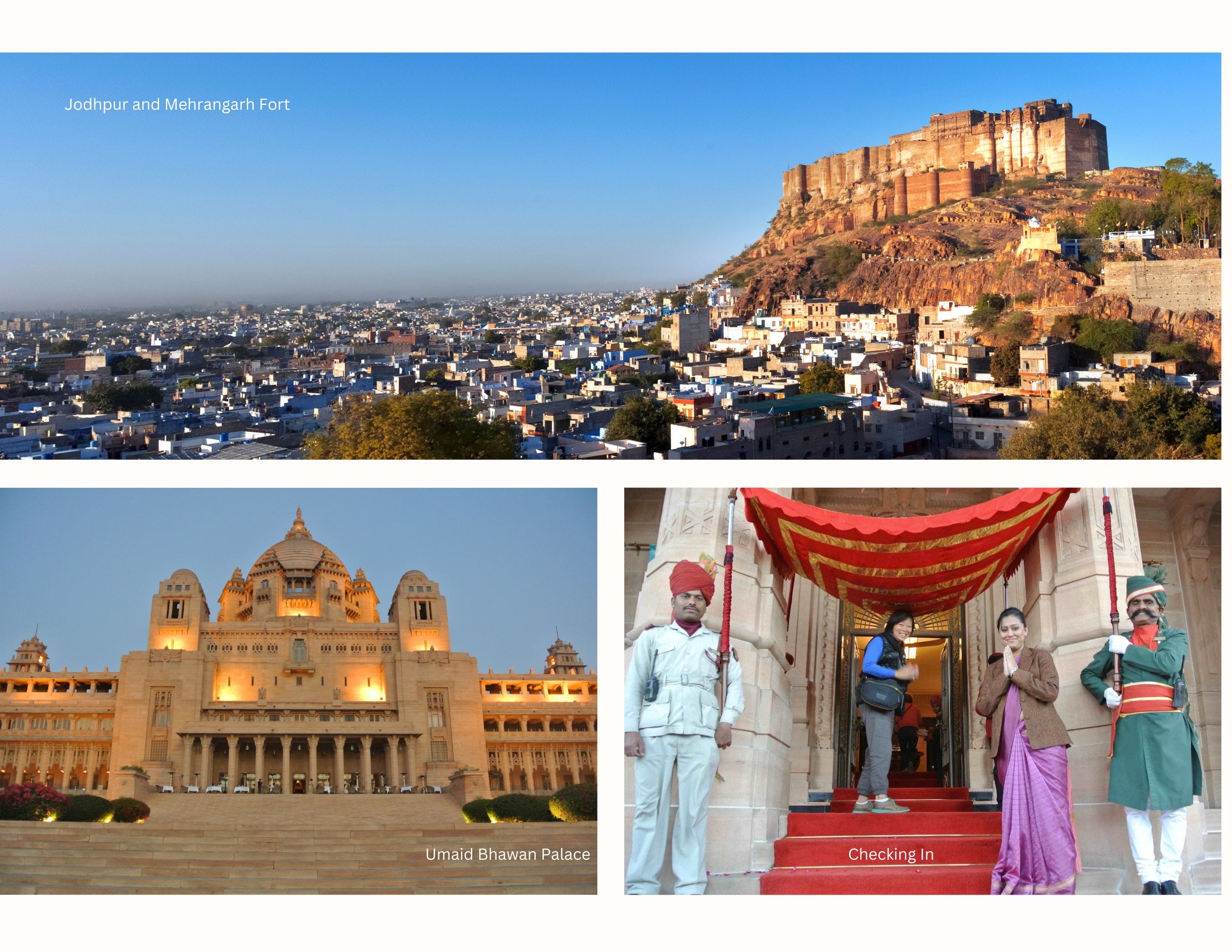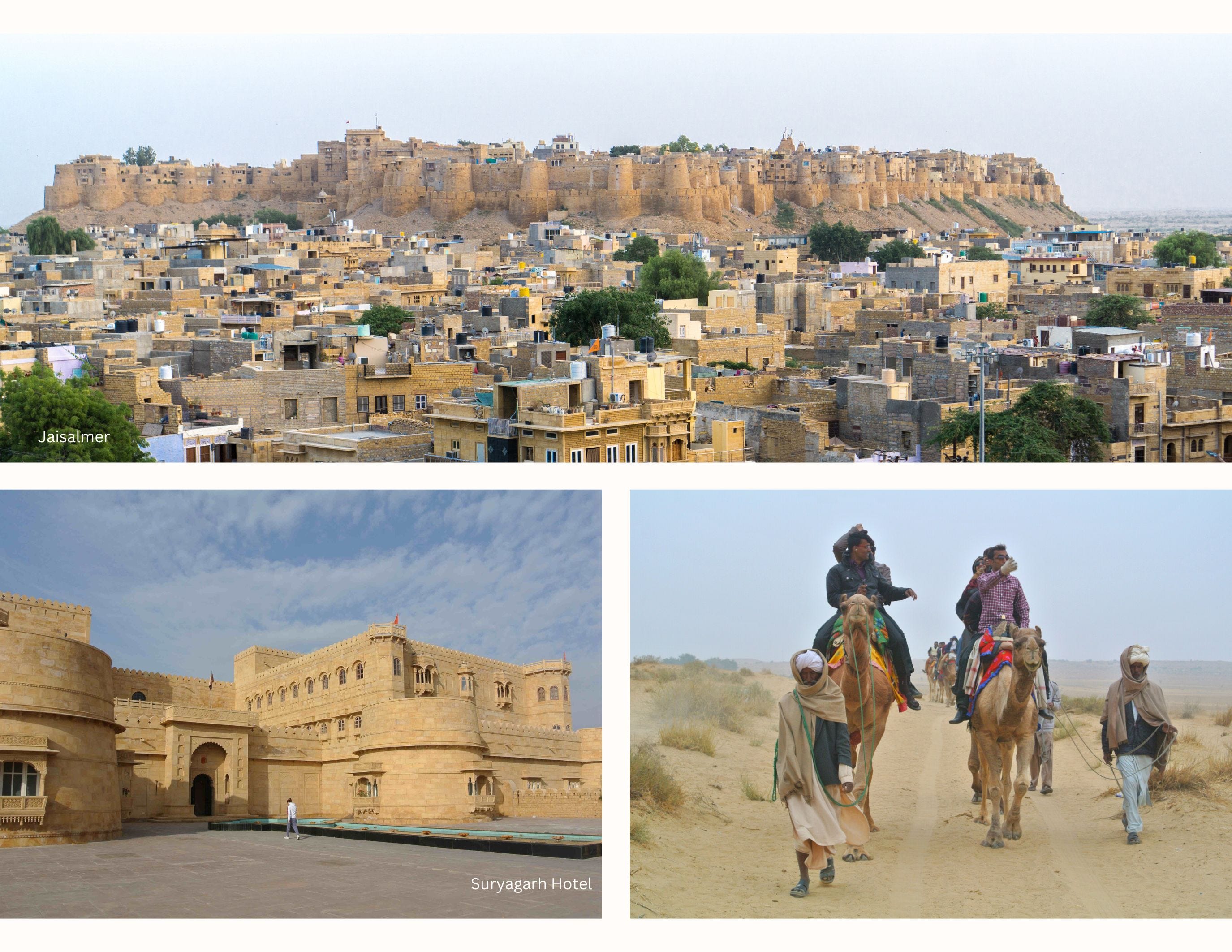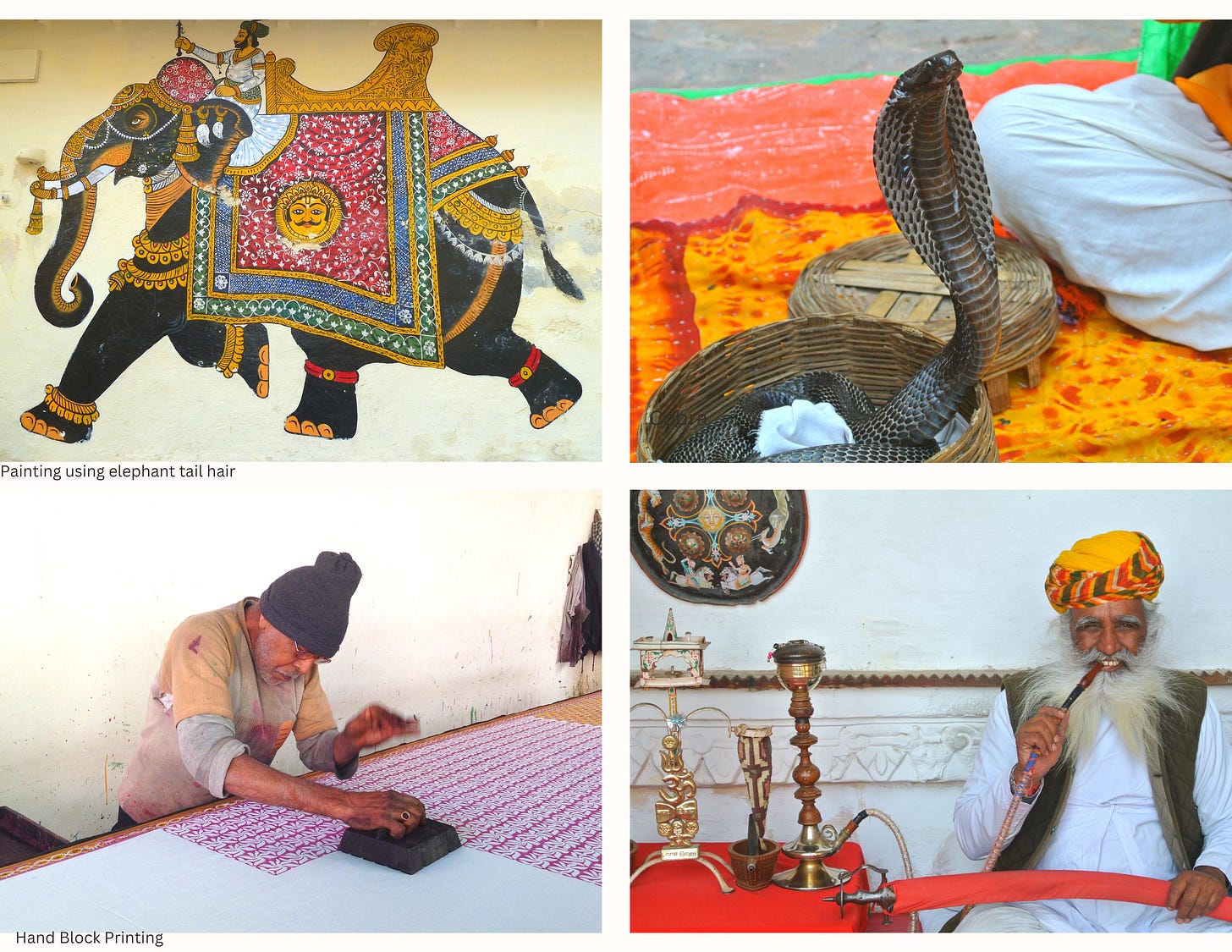You’re receiving this email as a subscriber to A Voyagist Newsletter. Thank you!! If you know someone who may enjoy it, please pass it along!
When our well-traveled friends from Montreal, Hubert, and Nicole, invited us to join them on their January tour of Rajasthan, we were hesitant. His assurances that it was 5-star all the way seemed out of our price range. Five stars for nearly two weeks? Yikes! “Not at all,” he said, “I have found the secret to booking a tour in India.” More on that a little later in our Black Book. It was clear they had done their homework, picking the best destinations and itinerary (Delhi, Udaipur, Jaisalmer, Jodhpur, Jaipur, and Agra) and some gorgeous hotels. We would also have our own transport (a private 9-passenger bus and our own driver), plus guides to meet us at every destination. In addition, we learned winter is cooler there versus the often 45-50 °C heat of summer. Cool indeed. A little more than we counted on when a few nights hit 7°C.
Tip: Best to go in winter. April through June is scorching, and July through September, the monsoon season, is oppressively humid.
Day 1 • New Delhi
Arriving in Delhi before noon on the 5-hour flight from Singapore was easy, even in Economy. We were in the lovely Imperial Hotel by 1:00 PM and, once quickly settled, began our first of nearly two weeks of touring.
Delhi, a major city of 22 million, has two faces. New Delhi is the remnant of the British Raj. Dating from the early 1900s and completed in 1931, it is full of parks, broad boulevards, government offices, and headquarters for all military branches. It is very much an oasis of green versus Old Delhi. The old British officers' housing, rather grand with luscious gardens, is even now, by any standard, impressive and assigned to parliament members at no cost, a rather lovely perk. Old Delhi is very different from New Delhi. Dating from the mid-1600s, it was once a walled city dominated by The Red Fort. The walls of the Fort are now mostly gone, but the impressive gates remain.
Dominating the New Delhi landscape is India Gate, an arched memorial constructed in 1921 to commemorate 90,000 Indian soldiers who died in WWI. It is the long parade leading from it where India has their Republic Day Parade showcasing all its newest military hardware to impress Pakistan and China. The entire area has all the British affectations, like multiple roundabouts with giant government buildings, Parliament, etc., dominating the landscape.
By way of contrast is Old Delhi, largely framed by the Red Fort built by Shaw Jahan (of Taj Mahal fame) in 1639. Old Delhi has been a city of some sort since the 6th century, and today is the beating heart of this sprawling metropolis. It contains the 17th-century market Chandni Chowk that runs through the center of the once-walled city and has many important temples and mosques. It also contains thousands and thousands of people (millions, really) in a very confined space. In truth, we saved Old Delhi for the last day of our trip, and by then, we had enough of the teeming masses. We stayed in the car.
Day 2 • Udaipur
In the morning, we flew south to Udaipur on Spice Jet. Hubert and Nicole were impressed with the Bombardier Dash 8 built in their hometown Montreal but less so when the plane would not pressurize and we had to turn back, ears popping. A replacement Dash 8 got us to Udaipur, but this time, the cabins were overheating as the air conditioning broke. We felt Spice Jet was a bit too spicy for us; thank you.
Udaipur is a dream, a picture postcard.
Udaipur is a dream, a picture postcard. Dominated by Lake Pichola, an artificial freshwater lake built in 1362, it has many palaces built by a long succession of Maharanas, a title variation of Maharajas used in some city-states.
We arrive at a boat launch manned by a giant Sikh in uniform and set off for our hotel, The Oberoi Udaivilas, on the far shore. We later learn it is more easily reached by land, but the boat adds some character. We pass the Taj Lake Palace, built on a 4-acre rock in 1743 and completely abandoned in the 1950s until a 1969 restoration and a Taj Hotels remodel to 83 rooms in 1971. The Bond film Octopussy was shot there. Our water approach to the sun-kissed and glimmering Oberoi was beginning to feel quite special. The hotel was named the best resort in India by Travel & Leisure in both 2021 and 2022. It did not disappoint.
Built new on old hunting lodge grounds, its 30 acres of gardens, fountains, and pools are stunning. The public rooms are massive, and a highlight is an oval room with 5,000 pieces of glass in the ceiling lit by a table of just a few large candles. Some rooms face the spa pool, some the main pool, and some the old private zoo held over from its hunting lodge days. Our budget room is charming enough, with a balcony overlooking the fountains of the inner courtyard. The staff speaks perfect English and, once installed, everybody knows your name, and you never have to sign for anything. We book massages at the spa followed by a swim in the heated main pool, where we are the only guests in evidence. Dinner is on an outdoor terrace with charcoal braziers providing warmth on a very cool evening. Fantastic.
Day 3 • Udaipur and City Palace
In the morning, we are off to tour the City Palace. Actually, it is many palaces built on a rock starting in 1559. Most of the hill is faced with stone, with the palaces sitting on top. Now a museum, it offers a commanding view of the lake, the city, and all the smaller palaces on and around the lake. It is where my camera battery dies. More on that later.
That evening we booked dinner at the Taj Lake Palace and took the boat over just after dusk. The place is amazingly chic, and although some of the areas and the best restaurant are restricted to hotel guests only, we see enough to know it is an over-the-top destination. However, it is The Oberoi Udaivilas and not The Lake Palace that has been voted the best resort in Asia by Travel and Leisure magazine. Here is one reason why.
On our return to the Oberoi that night, I found that I had packed the wrong charging cord for my camera battery. That means iPhone-only shots for the next two-plus weeks. In the morning, I take the charger to the concierge and ask if, by some chance, he could find out if anyone sells Nikon equipment in town. I leave him the charger and head to the terrace for breakfast. In an hour, he comes to my table. A proper Nikon cord has been found and delivered, and my battery is being charged at his desk. In Udaipur!
There are several important sites in and around Udaipur. However, the Must Sees are The Lake Palace and The City Palace. I promise you will be ‘palaced out’ after another two weeks. There are SO many!
Day 4 • Udaipur to Jodhpur
Late that same morning, we embarked on our first major road trip, the six-hour drive to Jodhpur. En route, we made a scheduled stop at Ranakpur Temple, a Jain Temple built in the 14th century.
The Jain sect is an ancient, pre-Buddhist offshoot of Hinduism. Their aim is absolute purity; they don’t eat meat or eggs and avoid taking any life. The temple is carved from light-colored marble, and its 1,444 pillars are all unique. Abandoned for over 90 years, the Jains did an 11-year restoration re-opening the temple in 2001. The temple guards are vigilant, no leather (belts, bags, etc.) is allowed, and cameras require a fee of 100 rupees. Shoes, as usual, are left outside. The detail, the intricate marble carving, the symmetry, and the silence are amazing. The bathrooms, however, are not. India is very good at temples…the bathrooms…not so much.
The detail, the intricate marble carving, the symmetry, and the silence are amazing.
As we moved on, we drove through moonscapes of marble and granite quarries and took note of the first of thousands of Tata and Ashok Leyland trucks. India moves everything by truck. Usually in desperate states of repair, decorated like Christmas trees, and very often dangerously overloaded. Villages seem to exist solely on vehicle repair. Trucks and buses line the side of the road, some with massive engines out and lying in the dirt, all leaking fluids at impossible rates. Nothing seems new, and all are beaten and worn. We saw trucks on the highway missing their cabs, just a seat and a steering wheel at 80 km an hour—buses with as many people on the roof as were inside and the ubiquitous Maharinda Major Jeeps. A CJ knockoff, it has many functions, principally as ad hoc public transport with as many as eight people crammed inside and more hanging off the back and sides. The road to Jodhpur is just two lanes. We saw many smashed vehicles on the side of the road and witnessed some heart-stopping near misses in the passing lane. Our driver, Mr. Singh, had a unique combination of bold and safe that we were very grateful for.
We saw many smashed vehicles on the side of the road and witnessed some heart-stopping near misses in the passing lane.
Day 5 • Jodhpur and Umaid Bhawan Palace
Eventually, we limp into Jodhpur at about 5:00 PM after a long day on the road. Clearly, there is a significant military presence in town as we pass base after base, and the sound of jets taking off at full power seems to surround us. We are getting closer to Pakistan. We drive up a long winding road, and as we reach the top, we have our first sight of the Umaid Bhawan Palace. OMG!
The 357-room Palace was built during the ’30s and finally finished in 1944. Now home to Maharaja Umaid Singh’s relatives in one wing, the hotel takes up only 64 rooms and suites, leaving more than a few rooms empty, say, about 200. Our arrival is not without fanfare. A red canopy has been raised; liveried staff is throwing rose petals on the red carpet. Jasmine garlands and requisite ‘bindi’ (a red dot applied to the center of the forehead to protect you from demons and bad luck) and welcoming drinks are offered. Feels just like home.
We retire to our rooms on the second floor and look out from our massive balcony at the gardens and manicured grounds stretching out before us. It took 3,000 workers to build this place over a dozen years. The gardens required 500,000 wheelbarrows of dirt, all manual labor, of course. Several of the function rooms are over 5,000 square feet each. The central atrium is 110 feet high and constructed without any mortar. Drinks at Pillars, the terrace overlooking the gardens, to watch the sunset and dinner with the warming charcoal baskets again. We are amazed.
Umaid Bhawan Palace. OMG!
On our way to dinner, I mentioned to the front desk that our toilet wouldn’t flush, and they were aghast! Dinner included some excellent French wines picked by our travel companions. When it came time to sign the bill, the manager arrived and said dinner was complimentary due to our inconvenience! Hubert said I must break the toilets everywhere we go! There is a very interesting museum on site, and the ornate indoor pool rivals anything we’ve ever seen, including the pool at Hearst Castle in California.
Day 6 • Jodhpur and Mehrangarh Fort
Regretfully, we only have one night and are off again in the morning to tour the Mehrangarh Fort. Built in 1459, it towers over Jodhpur and has the finest museum we’ve seen yet. You enter through 7 gates and look down upon the Blue City from the ramparts. The blue wash is believed to have been started by the upper caste, the Brahmins, to separate themselves from the rest. Then, everybody did it. It is a warm contrast to the beginnings of the Great Indian Desert, The Thar, which begins just outside the city. The museum has fabulous, jeweled rooms and galleries full of Howdahs (elephant saddles) and Palanquins (a rickshaw for women). One on display was built for Queen Victoria but never used. She couldn’t fit. Wonderful place.
On our way back to the Umaid Palace to pick up our bags and drop our guide off, we stopped at a huge antiquities store with a fabric shop in the basement. Ellen and Nicole disappear while I wander through a warehouse full of amazing things; giant, ornately carved statues of Ganesh (the elephant God) to old camp chairs with Coors Beer logos. While there, a man bought two life-size, intricately carved wooden horses for his daughters; gorgeous things; they were 2,000 USD a piece. After much haggling downstairs, we departed very late but laden with pashminas and fine tablecloths. Only later did we discover they might not be as valuable as we thought they were. If it’s really cheap, it’s really fake.
Now, we are quickly in the Thar desert, which is not pretty. Mile after mile of scrubby bush and rocky sand is only broken by the occasional village dedicated to, what else, vehicle repairs. We are heading for Jaisalmer, an ancient desert outpost that made its living by taxing the overland caravans for centuries. Then, with partition and the separation of India and Pakistan in 1947, no more caravans, and it slowly crumbled into the dusty little rat hole it is now. The population of fewer than 50,000 is supplemented by nearly 200,000 Indian military as Pakistan is just 40 km away. Almost. They have a ‘no man's land’ beginning 20 km from the border, and no one gets past that. We were very late due to the shopping and arrived in the dark. Our driver, Mr. Singh, gets pretty lost, and we wander about for an extra hour before we find our hotel, the Suryagarh, just 15 minutes out of town.
We are surprised to find it’s a replica fort, not a real one. While it is a pretty ambitious idea, we have been spoiled by three excellent hotels up to now, and this place is not quite near their level. However, it does have its quirky charms. I’m up early in the morning, and in the central courtyard, a turbaned man serenades us with a flute from an upper window. The house dog, a Golden Retriever named Alexander, drops by to say hello. Peacocks land in the fountain and fluffy doves will sit on your head and arms for photos. The staff is friendly and trying hard, but it hasn’t got the creds of a real 5-star. Still not bad for Jaisalmer, I guess.
Day 7 • Jaisalmer
In the morning, we are off to Jaisalmer Fort. This one is genuinely ancient, having been built in 1156. Made of sandstone, it is deteriorating badly because it is a ‘living’ fort with a quarter of the town's population living inside. That means wastewater, among other things, goes into the ground, causing it to swell. Cows wander here as they do everywhere, and I’m sorry, the place is just a sewer. We went to another Jain Temple (not nearly as nice as Ranakpur Temple), had tea at a lovely boutique hotel Hotel Killa Bahwan overlooking the town, and left having seen and smelled enough for the day.
Next up were camel rides at sunset. I had to be arm twisted to do this camel thing again (having done it in Dubai) and still refused to ride versus the camel-powered cart. The sand started to whip up, no sunset, and on arrival at the designated place, we were surrounded by a hundred camels, about 50 tourists, a few dozen begging children, and sand dunes pocked with every kind of garbage. I personally think war with Pakistan might improve Jaisalmer. It is a dirty, dusty desert hole and not worth the trek. If you must, there is a Relais & Chateaux called Serai we spied on the road back to Jodhpur that looks very nice.
Day 8 • Jaisalmer to Nimaaj
I had tried very hard to book a flight from Jaisalmer to Jaipur. There is an airport, a former military one, and I have seen pictures of the finished terminal. However, despite many comments about ‘opening soon’ dating from 2012, it still wasn’t six years later. It is open now, but Spice Jet, who fly to and from Delhi, suspend flights in the summer as it is too hot for tourism. So, we faced our longest drive of the trip. Long enough, we had to break it into two with a stop in Nimaaz, and it would still be an 8-hour trek just to get there. Although it didn’t take too many hours to leave the worst of the desert, the villages along the way had that same sad look; families living on the side of the road, cows and goats and dogs. I had been keeping a road kill count and got to three dead cows, five dead dogs, a goat, and a lamb. Then, we saw our first dead guy, which wasn’t funny anymore. We think he was punted off his scooter by one of the big trucks and lay in a crumpled heap on the roadside, surrounded by about 20 people. He was the first but wouldn’t be the last.
We hit Nimaaj at dusk and promptly got lost. With instructions via mobile phone, we finally made it to our hotel (The Lakshman Sagar) an hour later in the dark. Tonight, we were splitting up as the 5-star tented hotel only had one room for Hubert and Nicole. We were a bit nervous about that, but we were in for a pleasant surprise.
We were a bit nervous about that, but we were in for a pleasant surprise.
This small property with eight bungalows is a former hunting lodge. The trek to your room up and down rocky trails by flashlight is daunting, but the charming stone and mud-walled hut we found were very cool with a large bedroom, living room with fireplace, a nice big terrace with plunge pool overlooking a small lake, and Australian Shiraz in the fridge.
We were invited to have cocktails at a large fire pit in front of the main building, where we met an American doing a bit of a tour following his brother's wedding in Delhi. Dinner was lovely, and sleep came quickly in total silence except for a roaring fire they started for us.
Good thing we slept well as we were up for the nature walk at 7:30 AM. Equipped with hand-whittled walking sticks, we walked the cliffs around the lake, following a herd of antelope just below us. Then, we descended the hill and walked through a field to have our ‘Field Breakfast.’ The lodge arranges for a local farmer's wife and daughters to cook a traditional breakfast outside that’s served on a white tablecloth with white cloth-covered couches. Not sure about all of what we ate, but there was fresh buttermilk that Ellen churned (a bit) and various breads with yogurt and ghee. It was really different, very good, and the farmer’s kids were charming, providing me with the best picture of the entire trip. Great place. Not 5-star, as you would get at an Oberoi, but so glad we got to see it and experience a little bit of real life.
Day 9 • Nimaaz to Pushkar to Jaipur
On the road again. This time another six hours to Jaipur with a stop in Pushkar. A little town famous for its camel fair and auction, bringing 50,000 camels to dress up and sell for two weeks in November. And 400,000 people!!! Pretty good turnout, given there are only 14,000 people actually living in Pushkar. The town also has one of the few Brahmin temples (locals say it is the only one, but there are four more in India). Legend has it Lord Brahma shed a tear on the death of his wife, and one of the tears created a pond. Another version says it was a lotus leaf. That rather large pond now has 52 ghats, bathing places for the worshippers who arrive at the rate of 6,000 a day at dawn on the morning of a full moon. We go to the temple, and I take a pass as it requires removing shoes for the 10th time and a half block walk through the cow-crap-filled street to the temple. By the look on the faces of my compatriots when they returned, I made a good call. Nicole threw her socks out of the window of the van.
There is more to Pushkar, but more time is needed. We speed along to Jaipur. The capital of Rajasthan, this city feels different, perhaps because it was the first planned city in India, divided into seven sectors separated by broad boulevards 34 meters wide. We arrive at the Oberoi Rajvilas, a 32-acre property complete with its own restored 280-year-old temple and a Rajasthani mansion that now serves as its spa. The drive from Pushkar was less than 5 hours, and we settled into our tented villa and had dinner and an early night. On our return from dinner, we found the maids had hand sewn a pillowcase for Ellen’s travel pillow. Seriously? Have you ever seen that anywhere?
Day 10 • Jaipur
The following day we head out to The Amber Fort, the most spectacular we’ve seen so far, especially with the added attraction of an elephant ride to the top. They use 100 female elephants for the steep uphill trek, and you sit sideways, having stepped onto the ‘howdah’ from an elevated platform. We are told to pay the mahout (the person who steers the elephant) a 50 rupees tip. I give him 100, and he complains. He wants 200, or he won’t let us off. For some reason, I feel I’m being gouged for the extra 1.50 USD, and I refuse. It takes the cops to move him along for our exit.
Tip. While there are around 100 elephants, they are only allowed five daily trips each. Go early.
The fort, built in 1592, is fabulous. The Hall of Mirrors has inlaid pieces of mirrored glass by the thousands. It is said the light of one candle reflecting from all the glass can light the enormous room. The museum is excellent, and while everyone is in the bookshop, I pet a cobra outside. Yes, one of India’s one million remaining snake charmers has set up shop on the exit ramp. While The Wildlife Protection Act banned their craft in 1972 due to cobra cruelty, these remaining ones formed a union and continue today, although mainly as snake removal specialists. This particular snake has had its venom glands removed, shown by the indentations behind the eyes; some have their mouths sewn shut or their fangs plugged with wax or broken off. Still, seeing it rising from the basket, spreading its hood is quite something. I admit it was a bit of a rush, but I won’t need to do it again, ever.
We like Jaipur. It is known as the Pink City as the buildings were all tinted rose pink after an experiment with different colors to cut down the sun's glare for a visit by the Prince of Wales in 1876. Next, we head for the Palace of the Winds, an impressive 5-story façade built in 1799 with 953 lattice-covered windows to allow the royal ladies to view the street unseen. But, it is a façade with only small rooms and access corridors behind it. The lattice is designed in such a way as to create a venturi effect cooling the small interiors. Traffic in this area is horrible, and getting out for a closer look is impossible on this day. We missed the small museum inside.
Day 11 • Agra and the Taj Mahal
On to Agra and the Taj Mahal. Jaipur to Agra is one of our shorter trips, and Ellen and I are alone with Mr. Singh now as Hubert and Nicole have another car and are heading south to see a tiger. We are staying at another Oberoi, the Amarvillas, which is directly in front and 600 meters from the Taj Mahal, so we are told. It would be if you could even see it through the smoke and fog. While the grounds here look lovely, this is not the most impressive of the Oberois we have stayed at. It feels older and a bit tired, even if the outdoor spaces are lovely. Our guide advises that the fog and smoke could burn off the next day by noon and to see Agra Fort and the Baby Taj first. It was good advice as we couldn’t see 100 feet in the morning. It is winter in Rajasthan, and in the morning, people light hundreds of small fires on the street for warmth and cooking; mixed with the morning fog, it hangs like a blanket over the city.
This is not the most impressive of the Oberois we have stayed at.
Agra Fort is enormous. Its 70-foot tall red sandstone walls date from Akbar's rule in 1558, but there has been a fort on this spot since the 11th century. Shaped like a bow or a crescent, it once had 500 red sandstone buildings within its walls, but most were destroyed by Shah Jahan, Akbar’s grandson, for his preferred white marble. Now, only 30 red stone buildings remain. This place has a great history, but it will always be best known as the prison where Shah Jahan’s son kept him locked up for the last eight years of his life. Every day he could stare at the Taj Mahal downriver, where his beloved wife Mumtaz was entombed before joining her in 1666 when he died at age 74.
Finally, we arrived at the Taj Mahal, and the skies were clear. They were built by Shah Jahan in 1632 as a memorial for his wife Mumtaz, who had died giving birth to their 14th child, their 14th child in 19 years of marriage. Wow!
The Taj was built from white marble dragged by elephants from quarries 400 km away. It took 20,000 workers 12 years to build and created much discontent as Shah Jahan diverted food from locals to his craftsmen. It is nothing less than spectacular, but when you get up close, you are completely overwhelmed. Time to speak of Pietra Dura. At the Taj Mahal and other palaces, it is the art of carving out intricate patterns in marble and filling them perfectly with inlays of precious and semi-precious stones. The entire face of the Taj is covered in it, and it appears seamless with no rough edges or grout showing. Practiced in Italy and dating back to Roman times, it was adapted by Indian artisans and is still a major industry in Agra today. From a distance, the Taj Mahal looks pure white, and it is only when you get closer you see the Pietra Dura inlays.
The Taj Mahal is without question one of the most beautiful structures in the world, full of mystery and rife with optical illusions created by its Persian architect.
The Taj Mahal is without question one of the most beautiful structures in the world, full of mystery and rife with optical illusions created by its Persian architect. The four minarets lean slightly outward so that views from a distance keep them perfectly straight. It also ensures that the minarets would fall outward versus onto the Taj Mahal itself in an earthquake. Then, there is the enduring love story of Shah Jahan and Mumtaz, who met at ages 14 and 15 and lived a fantastic life together that ended sadly until they were joined again and remain forever in the crypt below the Taj Mahal floor.
Day 12 • Back to Delhi
And then, we are done. The 200 km back to Delhi are on a new superhighway, almost empty due to the heavy tolls. Now the trip takes less than 3 hours versus the 7 hours on the old road. But, as it is a toll road, most giant trucks can’t afford to pay. That’s why it appears largely empty. Just as our driver is telling us this, we come upon a horrific accident, a shock as we have seen almost no cars or trucks. It seemed a few hours ago, seven big trucks and many cars barreled into a wall of fog, leaving a field of carnage; dumped loads, crushed cars, and smashed trucks. From the look of it, many fatalities, and for the next few miles, we saw flattened cars being dragged to the next exit by tractors. Road kill count went way up, we think.
And that is India, more particularly Rajasthan. Shocking poverty, endless piles of garbage, filthy streets, thousands of wandering cows, and crumbling infrastructure are all covered in the grime of life. Then, there are the gorgeous Oberoi hotels, the unforgettable Umaid Palace, the incredible forts, and, finally, the sheer beauty and elegance of the Taj Mahal. And, in the end, Hubert and Nicole saw their tiger: just one but the biggest and oldest in the park walking slowly right beside their open truck. Damn, sorry we missed that.
Rajasthan. You won’t like all of it, but you have to see it. It is spectacular.





